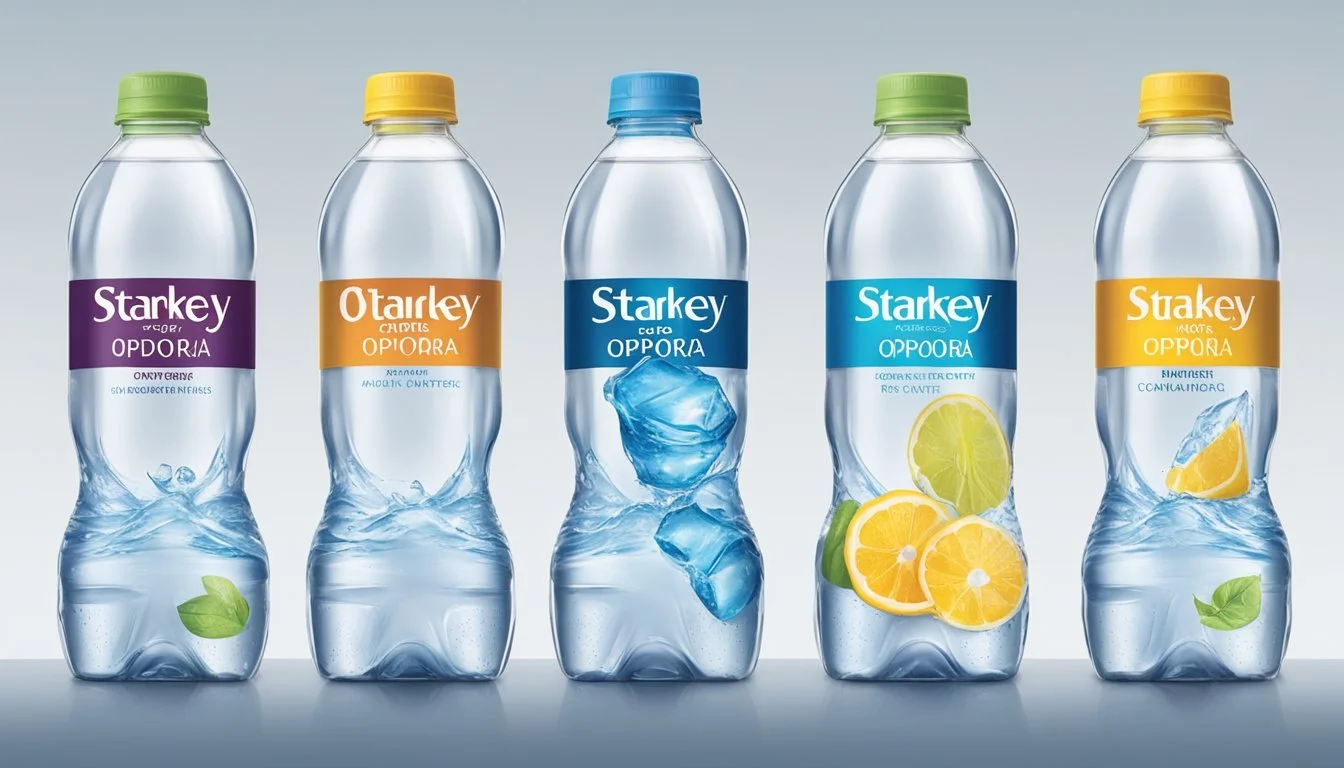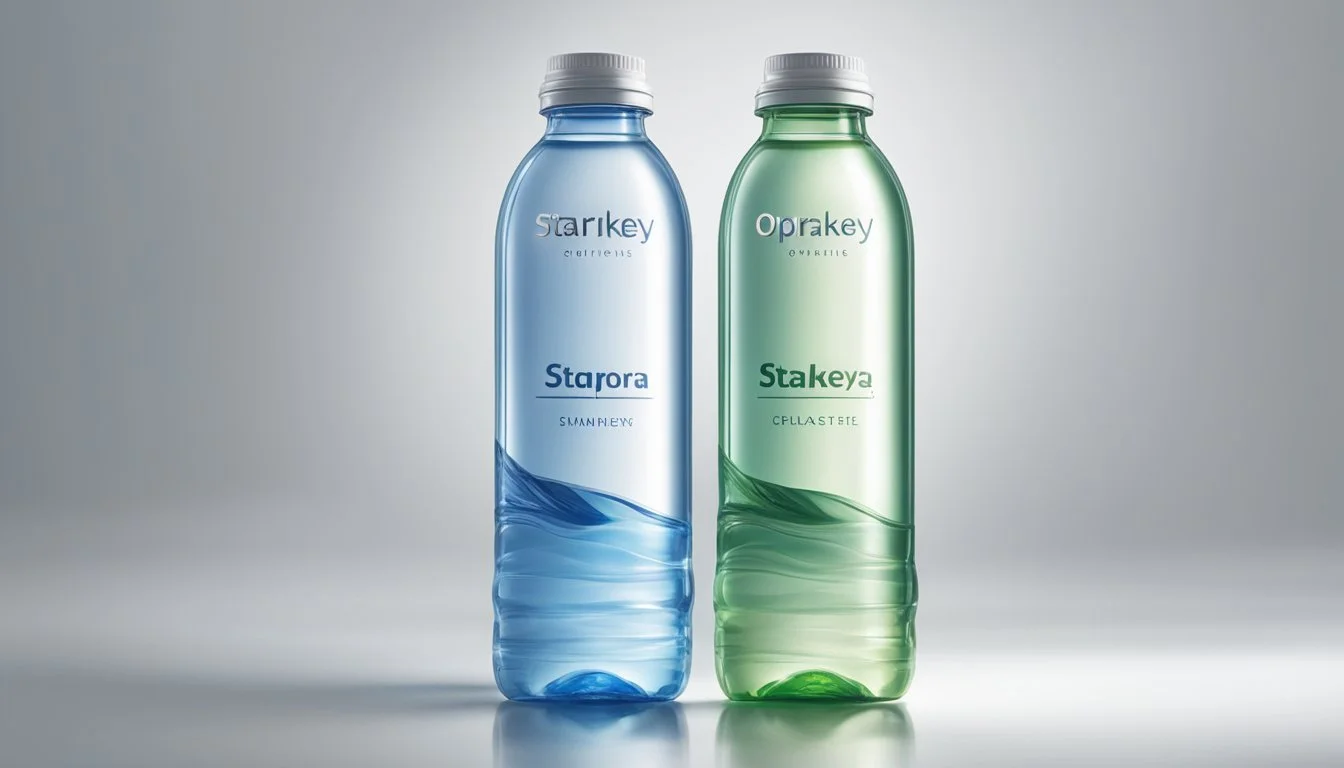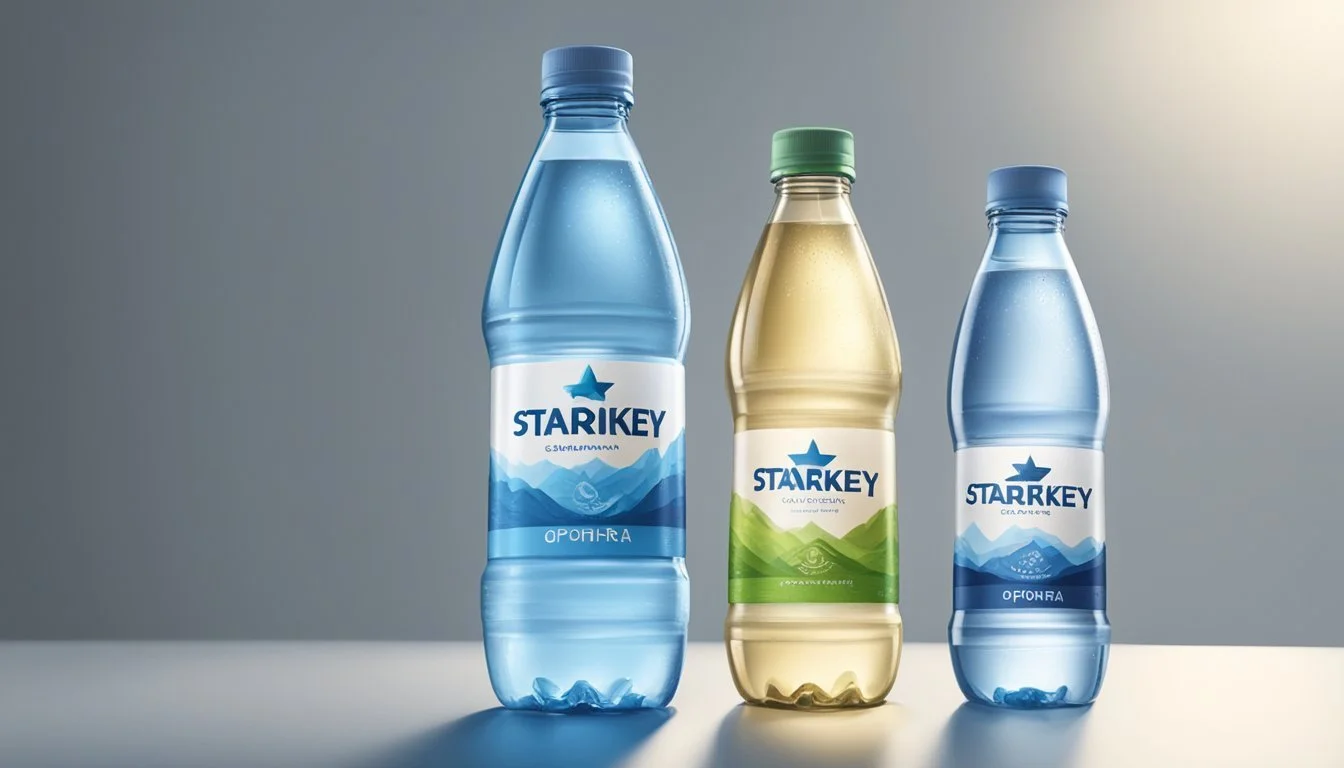Starkey vs. Ophora
Comparing Premium Bottled Water Brands
Choosing between Starkey and Ophora bottled water can be a challenging task, especially when both claim exceptional purity and health benefits. Starkey, sourced from geothermal springs deep within Idaho's mountains, boasts a unique mineral profile that many find not only refreshing but also rejuvenating. Ophora, on the other hand, is known for its oxygen-enriched water, promising enhanced hydration and a clean, crisp taste.
Ophora's emphasis on oxygenation sets it apart, potentially offering better hydration for those looking for an edge in their daily water intake. Starkey's natural mineral composition provides a distinct flavor that some water enthusiasts prefer, making it a strong contender in the bottled water market. This nuanced competition between the two brands highlights the evolving preferences of consumers seeking the best bottled water options.
In the ever-growing bottled water market, the preference between Starkey and Ophora depends largely on individual needs and tastes. Those who prioritize natural mineral content may lean towards Starkey, while those seeking enhanced hydration might favor Ophora. This article delves into comparing these two to help readers make an informed decision.
Understanding Bottled Water
Bottled water varies in its sources, treatment processes, and environmental impacts. This section explores the different types of bottled water, the regulations that govern them, and their environmental consequences.
Types of Bottled Water
Bottled water comes in various types, including Spring Water, Purified Water, and Sparkling Water. Spring water is sourced from underground formations and is often rich in natural minerals. Pure Life and Starkey are examples of brands offering spring water. Reverse osmosis is a common purification method for purified water, eliminating contaminants and minerals. Natural Spring Water offers a balance of purity and minerals, while sparkling water is carbonated for a refreshing taste. Mineral water is another category, containing specific amounts of natural minerals beneficial to health.
Bottled Water Regulations
The FDA (Food and Drug Administration) regulates bottled water in the United States, ensuring safety and quality. The FDA's rules cover labeling, manufacturing practices, and microbiological standards. In contrast, tap water is regulated by the EPA (Environmental Protection Agency). Bottled water must meet specific purity standards, and brands must disclose their sources and treatment methods. Ensuring products are BPA-Free is a critical regulatory focus, as BPA (bisphenol A) in plastic bottles can be harmful to health.
Environmental Impact of Bottled Water
The environmental footprint of bottled water is significant, primarily due to Plastic Bottles. Sustainable alternatives like Environmentally Friendly packaging are growing but not yet widespread. The production and disposal of plastic bottles contribute to environmental pollution. Sustainability efforts emphasize reducing plastic waste and promoting recycling. Some brands, like Pure Life, are adopting more sustainable practices, including the use of recycled materials and minimizing carbon emissions. Water extraction for bottling can also impact local ecosystems, making responsible sourcing vital for sustainability.
The Brands in Focus: Starkey and Ophora
Starkey and Ophora offer unique attributes within the premium bottled water market, each emphasizing purity and distinct sourcing methods. This analysis explores their origins, water sources, and the unique qualities that make each brand stand out.
Starkey: Origin and Overview
Starkey sources its water from a geothermal spring deep within the Earth's crust. Located in Idaho, this geothermal source has been producing water for over 11,000 years. The water emerges from the spring at a naturally warm temperature and is rich in minerals such as silica and bicarbonate.
This premium water is known for its soft, smooth taste and distinct mineral content. Bottled at the source, Starkey maintains stringent quality controls, ensuring purity and consistency. The brand positions itself as a natural, ancient water source, appealing to consumers seeking a unique, health-focused beverage.
Ophora: Brand Origins and Distinct Features
Ophora sets itself apart with advanced water technology and a commitment to purity. Sourced from a deep aquifer in Southern California, Ophora water undergoes a proprietary purification process. This includes oxygenation, ionization, and mineral enrichment, aiming to deliver an exceptionally pure and health-promoting water.
The brand highlights its focus on wellness by fortifying the water with essential minerals and oxygen to enhance hydration and health benefits. Ophora's sleek packaging and premium pricing reflect its target market: consumers willing to invest in top-notch quality and innovative bottled water.
By emphasizing cutting-edge technology and superior purity, Ophora stands out in the competitive landscape of premium bottled waters.
Quality and Purity Analysis
In assessing Starkey and Ophora bottled waters, it's essential to examine factors such as pH levels, mineral content, taste, purification processes, and contaminant presence. This analysis will provide a clear comparison of their quality and purity.
pH Levels and Mineral Content
Starkey bottled water boasts a natural pH of around 9.6, indicating its alkaline nature, which some believe may offer various health benefits.
In contrast, Ophora maintains a neutral pH level of approximately 7.4, which is more balanced for everyday consumption.
Mineral content in Starkey includes substantial amounts of bicarbonate, calcium, and silica, contributing to its unique mineral profile. Ophora features a blend of essential minerals, but it primarily emphasizes its oxygen-enriched content, aimed at enhancing hydration.
Taste and Palate Finish
Starkey water is known for its crisp, clean taste, underlined by subtle mineral notes that make it distinct without being overwhelming.
Ophora, enriched with oxygen, provides a smooth, almost creamy sensation on the palate, appealing to those who prefer a milder flavor.
The mineral content in Starkey often results in a slightly more complex flavor profile, while Ophora's focus on purity and oxygenation offers a refreshing, unintrusive experience. Both brands avoid the plastic-like taste sometimes found in lower-quality bottled waters.
Purification Processes
Starkey sources its water from geothermal springs, undergoing minimal processing to preserve its natural mineral balance.
Primary steps include filtration and UV light treatment to ensure safety and purity without extensive alteration.
Ophora employs a multi-stage purification system, including reverse osmosis, ozonation, and re-oxygenation, to deliver exceptionally pure water.
This method aims to eliminate virtually all contaminants while enriching the water with extra oxygen molecules for better hydration.
Presence of Contaminants
Starkey's geothermal source is naturally low in contaminants, and rigorous testing ensures the absence of harmful substances.
Consumer reports typically find Starkey free from notable contaminants, maintaining a high standard of purity.
Ophora’s thorough purification process targets a wide range of contaminants, aiming for near-zero presence. This commitment to purity is backed by frequent testing, ensuring the water remains uncontaminated by harmful chemicals or impurities.
By examining the specific elements of pH levels, mineral content, taste, purification, and contaminant presence, consumers can make a well-informed choice between Starkey and Ophora bottled waters.
Comparative Analysis
Starkey and Ophora are both premium bottled water brands, yet they cater to different consumer needs. Below, the aspects of pricing, market presence, consumer perception, and packaging are analyzed to determine their strengths and differences.
Price Comparison and Value
Starkey Water is priced competitively within the premium bottled water market. It is accessible to a wider range of consumers due to its fair pricing. Conversely, Ophora commands a higher price point due to its specialized production process and focus on health benefits.
Brand Price Level Key Value Proposition Starkey Mid-range Purity and mineral content Ophora High-end Health benefits and luxury
Starkey’s pricing strategy targets practical buyers, while Ophora is aimed at consumers willing to pay more for health-oriented, luxurious water.
Market Presence and Consumer Perception
Starkey Water enjoys strong visibility in upscale grocery stores and is often recommended by health-conscious consumers. Its mineral-rich taste and reputed purity make it popular among premium water enthusiasts.
Ophora, on the other hand, is highly regarded for its health benefits and specialized production. It is marketed as a boutique brand, often found in select high-end stores, restaurants, and exclusive venues. Both brands have carved distinct niches in the bottled water market.
Packaging and Accessibility
Starkey offers both glass and plastic bottle options. The glass bottles are favored for their eco-friendliness and premium feel. This assortment provides consumers with choices based on preference and convenience.
Ophora primarily uses glass bottles to emphasize luxury and health benefits. These glass containers are designed to enhance the overall drinking experience and maintain the purity of the water. While this adds an element of sophistication, it may limit accessibility for some consumers due to fragility and rarity in typical grocery stores.
Starkey’s diverse packaging and broader retail presence make it more accessible. Ophora’s exclusive packaging and targeted distribution underline its premium status, offering a distinct appeal to a specific demographic.
Hydration and Health Implications
Starkey and Ophora bottled water both offer unique benefits that can impact hydration and health. Key factors to consider include the role of electrolytes and the trace minerals present in each brand.
The Role of Electrolytes in Hydration
Electrolytes such as sodium, potassium, and magnesium are vital for maintaining hydration. They help balance fluids and support muscle function.
Starkey water contains natural minerals that contribute to its electrolyte content. This can be beneficial for staying hydrated during physical activities.
Ophora water, on the other hand, emphasizes its enhanced oxygen and purification processes. It's marketed towards health-conscious consumers looking for more than just hydration, but also benefits like detoxification.
Key minerals like calcium and magnesium in the water play a significant role in overall health. These minerals not only aid in hydration but also support bone health and muscle recovery.
In summary, while both Starkey and Ophora offer hydration benefits, the specific electrolyte and mineral content may make one more suitable depending on individual health needs and lifestyle.
Consumer Guide
Selecting the best bottled water involves considering factors such as source, purification process, and the presence of minerals or contaminants. This guide provides detailed insights to help consumers make informed choices.
How to Choose the Right Bottled Water
When choosing bottled water, consumers should prioritize the source. Natural springs like those used by Evian and Fiji Water often offer water with naturally balanced minerals.
PH levels are also important. Smartwater and Icelandic Glacial provide higher pH levels, which can be beneficial for those seeking less acidic options.
Mineral content, including calcium and magnesium, enhances taste and health benefits. Voss and Evian are recognized for their mineral-rich profiles. However, Aquafina and Dasani are purified and may lack these minerals.
Regulations and safety play a key role. Look for brands adhering to FDA regulations to avoid PFAS chemicals. Brands like Ice Mountain emphasize safety in their packaging and processing, ensuring a contaminant-free product.
Understanding Water Labels and Claims
Bottled water labels can be confusing, featuring various claims and terminologies. "Natural Spring" indicates water sourced directly from an underground spring, exemplified by Arrowhead Mountain and Icelandic Glacial.
"Purified Water" such as Dasani and Aquafina typically undergo extensive filtration processes, which may remove beneficial minerals. Consumers should be aware of potential sodium levels, as some brands add sodium for taste enhancement.
PH levels are often highlighted to attract health-conscious buyers. Values above 7, seen in Fiji Water and Smartwater, suggest alkalinity, while lower values indicate acidity.
Reading labels for added minerals like calcium and magnesium can guide those seeking specific health benefits. Lastly, always check for compliance with FDA regulations to ensure safety from contaminants, focusing on claims about the absence of PFAS chemicals and other harmful substances.
More About Starkey
Icelandic Glacial vs Starkey: Which Bottled Water is Better?
Mountain Valley Spring Water vs Starkey: Which Bottled Water is Better?
Starkey vs Kirkland Signature: Which Bottled Water is Better?
Starkey vs Richard's Rainwater: Which Bottled Water is Better?
Starkey vs Whole Foods Italian Still Mineral water: Which Bottled Water is Better?







